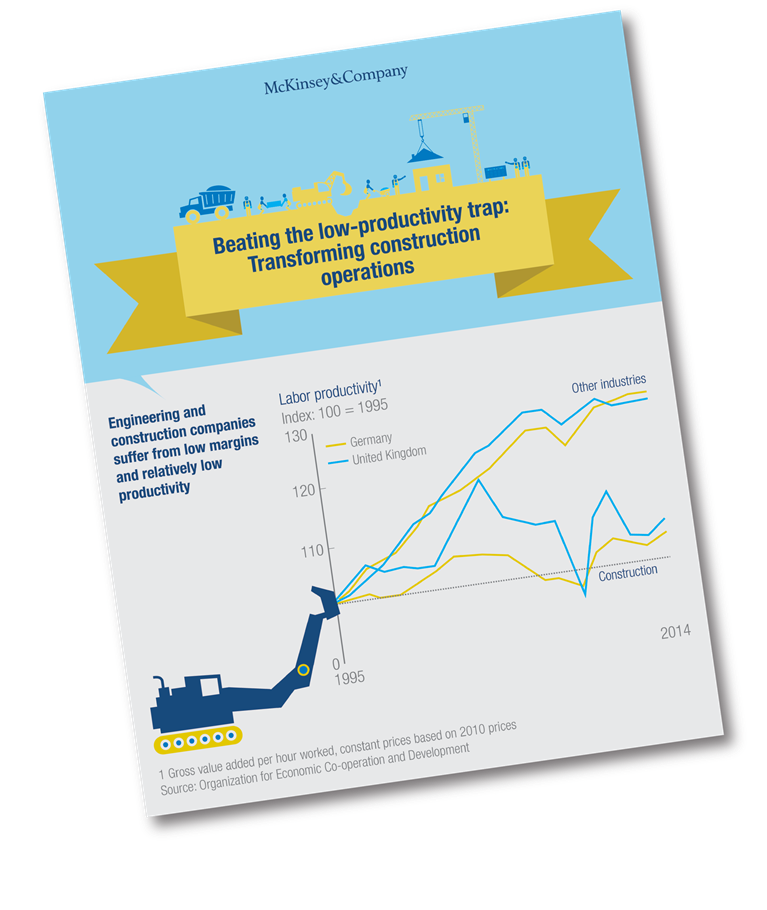Infrastructure providers have reason to feel optimistic. The McKinsey Global Institute has estimated that $57 trillion worth of infrastructure investments will be required by 2030 just to keep up with the global economy.1 For engineering and construction companies, that translates into a steady 4 percent annual growth rate. Many industries would be happy with that prospect.
Despite the positive outlook, the sector is struggling with stagnating productivity and low profit margins in many markets. For example, while overall labor productivity in Germany and Britain has risen by almost 30 percent since 1995, construction labor productivity in those countries is up by only about 7 percent over that period (Exhibit 1).

What’s more, McKinsey recently analyzed the financial performance of 30 major public engineering and construction companies from 2005 to 2015. Fewer than 15 percent consistently enjoyed double-digit growth and margins for earnings before interest, taxes, depreciation, and amortization (Exhibit 2).

These results are not as good as they should be. In essence, engineering and construction companies are professional-services organizations: they use their distinctive know-how to provide specialized forms of business support to clients, from the initial idea to design and execution. Other types of professional services target—and often achieve—30 to 40 percent operating margins. The higher end might be out of reach for engineering and construction companies, but we believe that 20 to 30 percent is possible if they design their operations differently and focus not on utilization (for example, by taking low-margin business to keep resources at work) but on profitability. Clients are looking for higher-quality and more cost-efficient solutions grounded on more productive technologies and methods. Engineering and construction companies able to bring such value-enhancing solutions to clients will likely enjoy better margins.
In this article, we describe the challenges, both internal and external, facing the sector. Then we suggest specific moves that companies in it can make to improve their productivity and profit margins over the long term—and in the process help to build the infrastructure a growing world needs.

View and download our infographic explaining how engineering and construction companies can beat the low-productivity trap.
Internal challenges
Our work with engineering and construction companies around the world suggests a number of common flaws that impair their performance and ability to innovate. These include the following issues:
Shortfalls in accountability. This problem is a major element in the consistent failure of companies to deliver projects on time and on budget. Organizational structures are frequently unclear, so that no one takes responsibility for results, and financial incentives often are not aligned with project goals.
Talent management. Engineering and construction companies everywhere complain that they can’t find or keep enough people with the right skills. Few can develop talent internally. In addition, many people don’t want to work in difficult or risky regions. These companies, believing that only engineers with long records in the field can succeed, have resisted hiring from outside it—a reluctance that has limited the industry’s ability to reinvent itself and to learn from other sectors. Most engineering and construction companies, for example, lack leading-edge sales capabilities, such as strategic-account management and cross-selling.
Reinventing the wheel. Many functions in the sector are risk averse and reluctant to share best practices. Often, companies run business units and megaprojects as if they were independent companies, without consistent performance management. Each project is treated as if it were one of a kind, so that margins can vary even for comparable undertakings.

Would you like to learn more about our Capital Projects & Infrastructure Practice?
By not standardizing operations and project reporting, companies don’t manage risks or scale up best practices as well as they could. No two projects are exactly alike, of course, but that’s no reason not to learn from experience. The failure to do so is yet another example of the way the sector has been slow to adapt techniques and technologies from other fields. Industries such as mining, for example, use digital innovations to improve their productivity and find new ways to manage variability.2
Failure to adapt to new technology. Some companies have tried to adopt innovative productivity-enhancing methods, such as advanced 5-D building-information modeling (BIM)3 and the collection of data from drones and construction workers’ smartphones. One major global contractor, for instance, recently worked with a construction manager to develop a field-supervision platform for large-scale construction projects—an effort that improved worksite productivity. Most companies, however, have legacy systems and unique requirements for budgets, planning, and operations, so change is difficult.
Problems utilizing resources. As engineering and construction companies have grown and diversified, they must increasingly deal with internal silos organized by geography, business unit, asset class, or any combination of these. The result is that they struggle to use their resources as effectively as possible.
All these factors have created a culture of sluggish innovation. Change doesn’t come easily to an established sector, like engineering and construction, that serves many different stakeholders very publicly.
External challenges
Outside factors can also make it difficult for engineering and construction companies to improve their efficiency and profitability.
Fragmented value chains. The project life cycle includes many different players, such as owners, designers, contractors, and quality-control and safety experts. This is a fact of life; the problem is that the different parties don’t always work together well—for example, each typically gets its own contract, with no overall management. In effect, one participant can (and often does) create problems for the next. The basic issue is that priorities often differ, so it’s hardly surprising that designers, say, don’t necessarily aim to maximize cost-efficiency or that contractors simply pass on additional costs to the owner rather than work together to reduce them.
Extensive subcontracting. Many subcontractors are small and unsophisticated, lacking effective governance and talent management, and the companies that hire them don’t see it as their responsibility to improve matters. That affects productivity not only at the specific stage where a subcontractor is hired but also at every stage thereafter. Also, engineering and construction companies typically want subcontractors to accept most of the risks—an attitude that doesn’t foster a spirit of collaboration.
Thus, a significant number of contracts between subcontractors and engineering and construction companies do not provide incentives to encourage the best ways to work. While owners aim to complete projects on time and on budget, the subcontractors may have different goals: they typically want to maximize their revenues (and margins), especially if no penalties are applied for delays or if they have already hit the maximum penalties specified in their contracts.
Complex portfolios. International expansion means that many companies deal with a number of different business environments and partners—and this can promote even more atomized ways of working because of the need to build up regional knowledge. And the variety of local regulations makes it more difficult to standardize operations.
Competitive pressure. Chinese, South Korean, and European companies in particular are making great efforts to find work in high-growth markets. This heightened competition is forcing once dominant local players to raise their game at a time when other kinds of pressures, such as tougher environmental and safety standards, are also building. Moreover, high-profile projects are the subject of constant comment. In such a pressured environment, steady improvement—much less transformational change—isn’t easy.
Coping with complexity. Projects are getting more complex, and there are more megaprojects—those that cost at least $1 billion. Clients are more demanding, insisting on what and how to build and refusing to countenance changes in design or procurement that would improve productivity. Contracts are also much more complex.
How to do better
Successful engineering and construction companies set appropriate goals and ensure that managers and workers understand them. They learn from their mistakes and successes, embed these lessons in future projects, build uniform practices, and take advantage of new technologies. To boost margins and productivity, here are the priorities:
Articulate a clear set of values and targets. This point may seem obvious, but many engineering and construction companies find it hard to estimate baselines, and that makes it all but impossible to develop accurate plans. Creating a culture of measurement and precision about estimates is essential. Successful companies promote this mind-set—and ensure that they and their employees have the same goals—by tying performance bonuses to specific metrics in the execution of projects.
Many big engineering and construction companies operate on several continents and have grown through acquisitions. Under these circumstances, creating a cohesive corporate culture and a single set of values is difficult. To overcome this problem, it’s necessary to tell a compelling story that involves the entire organization. Our work has found that in companies that have done so successfully, senior executives identify specific themes and then work on them with employees for years. Once they select the themes—common ones include enhancing accountability and improving standard operations—companies devise practical ways to realize them. Then they train their employees and try out the new approaches in pilot projects, learning what does (and doesn’t) work before disseminating practices more widely.
Most successful transformations are directed from the top down. Leaders need to set the tone: early and often, they should make the case for change by identifying the challenges the organization faces and then explaining how they plan to address them. Because what gets measured gets managed, companies must establish a performance and health baseline to set and track ambitious goals. A major engineering and construction business, for example, was concerned about the erosion of its profit margins, so it examined the reasons for this trend and then took action. Among other things, it exited markets where it was performing poorly and improved its risk-management processes.
To track performance, engineering and construction organizations typically focus on hard metrics such as cost efficiency and productivity. Our work suggests that they are more likely to reach their goals if they also manage cultural, values-based, and employee-commitment metrics (such as perceptions of accountability) that are directly related to their ability to deliver projects.4
Build a development program for project managers. To promote excellence, encourage constant improvement, and increase personal accountability, companies should design career plans for project managers. Even relatively small companies can do so through mentorship, well-designed performance evaluations, and feedback mechanisms.
For bigger companies, a more ambitious approach involves designing an internal university: training programs to develop talent and strengthen capabilities. Successful programs not only train high-performing employees but also help companies retain them. The curriculum could include the following subjects:
- Project planning. Ensure that project engineers and managers are trained in critical paths and “last planner” methods designed to produce predictable work flows and rapid learning in design, programming, construction, and commissioning.
- Contracting strategy. Investigate proven methods (such as activity-based cost modeling) that generate better or less expensive ideas. Share cost-saving technical solutions with subcontractors.
- Performance management. Show employees how to measure performance against budgets and how to create and monitor cost-loaded schedules.
- Change-order management. Teach employees how to evaluate proposed changes and develop accurate cost trends, as well as when and how to create detailed and justified change orders.
- Project risk management. Demonstrate risk-assessment methods, including how to create risk-adjusted budgets and detailed risk registers and mitigation plans.
- Contract management. Explain the terms and conditions of different strategies, such as design to build.
Successful programs ensure that respected people in the organization participate as speakers and that they connect with talented young employees, perhaps by inviting them to off-site meetings or arranging for them to speak with the CEO on a regular basis. Partnerships with nearby civil-engineering programs are another way to offer substantive training, and its successful completion can provide credits toward a degree. Some engineering and construction companies have also worked with universities to promote research in areas where the sector needs to innovate.
Finally, mandatory rotation programs, both in geographies and business units, should complement all these elements: they enrich the development of project managers while improving internal mobility and maximizing the use of resources.
Create an integrated data system. A company needs to have a single database that shows the most important project metrics, such as progress in construction and real unit costs, so that managers can track their estimates. At present, each stage—planning, design, procurement, construction—usually has a separate database, and these may collect the same information in different ways, so that data are difficult to interpret. All too often, executives ask simple questions, such as actual costs versus projections, and cannot get answers or, worse, get different answers. Admittedly, companies must consider legal, confidentiality, and logistical issues. But if they make data integration a priority from the beginning, they can do much better.
Encourage speedy risk mitigation and decision making. Working with the business-development and operations teams, executives at engineering and construction companies need to create effective risk-management programs, with metrics that, for example, track progress and illuminate the risks of the entire portfolio. The current norm is to consider risk on a case-by-case basis; the better approach is to see how each project fits into a company’s operations as a whole. For example, if a company decides to offer a 10 percent discount on its usual profit margins for one project, other projects will have to make up the difference. The goal isn’t just to win work; it’s to manage the overall risk profile and avoid making decisions in the dark.
All parts of a company should be aware of its strategic priorities—growing aggressively, entering new markets, working in new asset classes—and create mitigation strategies to match. Companies should also establish feedback mechanisms to appraise their work after completion by asking managers of a project to evaluate aspects of it that they themselves didn’t oversee. Interviews and data analysis can help identify best practices and areas for improvement.

The construction productivity imperative
Make project-delivery teams more accountable. At the very beginning of a project, companies ought to establish what the team that runs it should do—before the team gets to work—and then choose the people who can accomplish those goals. It could be helpful to create a standard project charter that defines roles, responsibilities, and lines of reporting and to establish a clear documentation system. The staffing model must factor in differences in the size, complexity, and stages of projects to ensure that teams get the resources they need. Finally, companies should create clear links—including compensation—between individual performance and how well and quickly projects are completed.
Standardize systems and practices. The engineering and construction sector has a tendency to reject standard solutions even when they clearly work. To reduce procurement costs and execution times significantly, companies should seek to ensure that all projects maximize the use of the best features from earlier ones. At present, it isn’t unusual for two designers to use, for example, slightly different HVAC systems on two different projects, increasing their complexity and costs for no good reason. That’s not surprising—in fact, it’s almost inevitable. Designers learn to optimize for loads and stress; project managers must add cost efficiency to the list of priorities.
Some of the most successful engineering and construction companies have established their own tools, systems, and procedures, in effect creating a distinctive “project-delivery way.” They have also learned how to communicate the idea that these methods generate savings for owners and subcontractors, too. Engineering and construction companies in the oil and gas sector have proved particularly adept at persuading their clients to adopt their reporting and data-collection methods and other techniques.
Standardization can open up other kinds of opportunities as well. Many specialized engineering and construction companies—such as those in the energy, mining, and utility sectors—are experimenting with approaches beyond the conventional lump-sum model, in which owners lock in a price and pass on all the risks to the contractor. Instead, these companies are putting in place more collaborative systems that involve working with contractors and subcontractors in earlier stages of projects and using novel mechanisms such as shared savings. This approach can cut costs and improve results significantly.
Create an integrated and transparent performance-management system. From the start, the budgeting process must incorporate an awareness of risks. Companies should not only maintain a matrix that ranks risks by likelihood and potential impact but also create detailed mitigation plans for those they deem probable and significant.
To ensure the early identification of execution risks, companies should have an integrated master plan with details on engineering, construction, and cash flows. “Progress curves” ought to track estimated-versus-real productivity, as well as recovery plans for delayed or underperforming activities. A project charter should identify all stakeholders in the owner’s organization, to help them manage risks. And an internal communication plan ought to show who is responsible for different relationships with clients and include a detailed calendar of meetings with them.
Minimize the number of changes. A stage-gate process identifies the specific points when project objectives have been approved. The process can help to increase efficiency and control costs, keeping changes to a minimum by ensuring that they are reviewed and allocating responsibility for approval. The process should build the following “gates”:
- Strengthen the business case. To increase analytic rigor in developing business cases, ensure that the operations and finance departments collaborate. Enforce a requirement to benchmark projections against the results of completed projects, and devote resources to evaluating the scope and strategic merits of prospective ones.
- Study the owner’s designs. Ensure that the proposed solution for a project complies with design standards and makes sense from both a technical and cost-benefit standpoint.
- Implement ‘cold-eye’ and constructability reviews. Undertaking cold-eye5 and constructability6 evaluations before signing contracts could improve a company’s selection of projects and cut the number of modifications for design omissions and errors.
- Establish a postmortem process. To identify pockets of excellence as well as areas that need improvement, evaluate projects after completion.
The engineering and construction industry’s traditional operating model is not as efficient or sophisticated as it could be. Many of the optimization tools that other industries adopted decades ago are only now becoming widespread in the construction sector. To fully benefit from the productivity improvements that new technologies can bring, engineering and construction companies have to act on their structures and operations first. Priorities include standardizing processes, creating an integrated and transparent performance-management system, and improving talent development. Companies that fail to do so will not only be vulnerable to existing competitors that get started sooner but also to new entrants willing and able to disrupt business as usual.
For most organizations, implementing these changes will require a major overhaul. To get started, companies must understand their potential and areas of strength and then set priorities. The commitment must come from the top: in our experience, most operational and organizational transformations fail because of a lack of leadership from senior management and a resistance to change from employees.
It’s hardly news that the construction sector is resistant to change. Yet even executives who accept the need to do things differently have tended to focus on improving specific functions, such as planning or procurement. That’s a start, but companies need an end-to-end approach; this kind of transformation is as much cultural as operational, which makes it all the more challenging. For most companies, doing what’s necessary will require a fundamental change in thinking, specifically by emphasizing profitability rather than resource utilization and becoming more selective about the work that’s targeted. But companies that make this shift will put themselves in a winning position.


